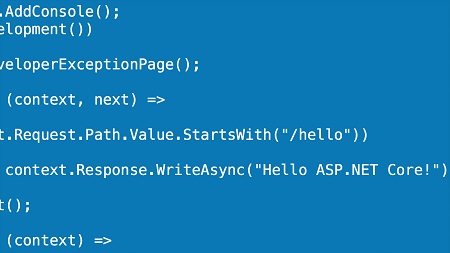
English | MP4 | AVC 1280×720 | AAC 48KHz 2ch | 3h 12m | 706 MB
ASP.NET Core 1.0, Microsoft’s latest web development framework, includes an optimized developer experience, better performing runtime, and cross-platform support for Windows, Mac, and Linux. In this course, introduces the basics to get you up and running with ASP.NET Core, and creating your own professional quality applications. He explores setup and installation, working with the ASP.NET Core framework, and the techniques you need to manage data, reuse code, construct web APIs, and secure your new applications. All of this is included along with industry-standard best practices such as dependency injection and the model-view-controller pattern for more modular code.
Topics include:
- Building blocks of ASP.NET Core applications
- Creating a new project
- Responding to HTTP requests
- Serving static files
- Understanding the MVC pattern
- Handling requests with controllers
- Routing
- Rendering HTML with Razor
- Rendering data, view markup, and view logic
- Creating HTML forms
- Validating form data
- Reading and writing from a database with Entity Framework
- Improving the user experience
- Exposing data with a web API
- Securing your ASP.NET application
Table of Contents
1. Introduction
Welcome
What you should know
How to use the exercise files
Development environment set up
Sample application introduction
Challenges
2. The Basics
Building blocks of ASP.NET Core applications
Create a new project
Respond to HTTP requests
Leverage external dependencies
Serve static files
Error handling and diagnostics
Use custom configuration
Populate configuration settings
Increase maintainablility with dependency injection
3. The ModelViewController MVC Pattern
Understand the modelviewcontroller MVC pattern
Add ASP.NET MVC to your ASP.NET Core application
Handle requests with controllers
Pass parameters to controller actions
Understand routing
Customize your applications URLs
4. Render HTML with Views
Render HTML with Razor
Render dynamic content with Razor
Reuse shared HTML markup with layouts
Pass data from the controller to the view
Render data with strongly typed views
Reuse view markup with partial views
Reuse view logic with injectable services
Reuse application features with view components
Reuse application features with view components, part 2
Challenge
Solution
5. Work with Data
Create strongly typed HTML forms
Post form data to controller actions
Validate form post data
Use tag helpers to simplify forms
Represent the database using Entity Framework
Write to a database using Entity Framework
Read from a database using Entity Framework
Challenge
Solution
6. Improve User Experience with Ajax and Web APIs
Avoid page refreshes with partial rendering
Expose web API endpoints
Expose data through a web API
Consume a web API from the browser
Challenge
Solution
7. Secure Your Application
Secure controller actions from unauthorized access
Add identity services to your application
Use identity services to create user accounts
Use identity services to allow users to log in to your site
Avoid crosssite request forgery
8. Conclusion
Next steps
Exercice Files
Ex_Files_ASPNET_CoreMVC.zip
Resolve the captcha to access the links!